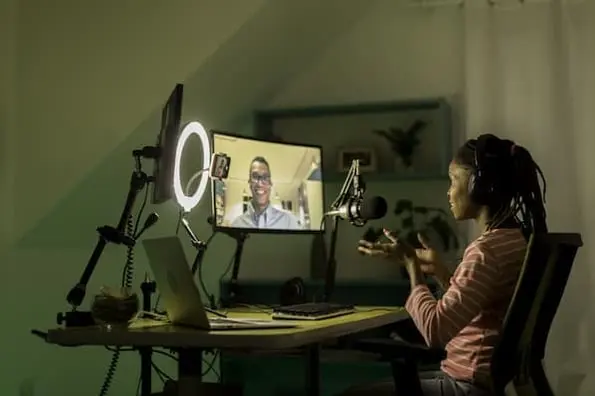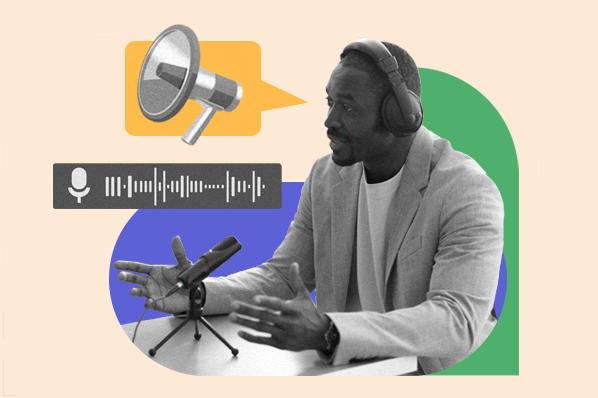You've had the thought. You know — the one that kicks in on your way to the store, during the daily traffic jam, or underneath your subconscious before you fall asleep each night: I should make a podcast.

One of podcasting's most endearing qualities is its accessibility. Not only can anyone make a podcast, but everyone should make a podcast. Yeah, I said it. Hot take around some circles.
Hitting the record button and talking into a microphone isn't exactly going to land you on NPR. Your supportive aunt Janet might throw you a listen, but most audiences today expect a higher level of quality than an unedited, forty-five minute piece of audio. Even Janet deserves it. She's such a loyal listener.

Editing a podcast means everything from cutting tape, to mixing tracks, to compressing audio. And the software you'll do it all inside is a digital audio workstation (DAW).
Your choice in editing software should first take a close look at your budget and goals — not your dreams of becoming the next Ira Glass.
Every D
AW is different, and the purpose each one serves varies, sometimes wildly. But there's a right DAW out there for everyone. So let's get you that meet-cute moment and take a look at the top podcast editing software.
Best Podcast Editing Software
1. Pro Tools
Pro Tools is the Tesla Coupe DeVille of podcast editing software. While it won't make you sound like a public radio program, it's more than likely the software they're all using to package up audio stories.
Pro Tools is the industry standard for a reason. It has every possible tool imaginable for recording, editing, and mastering your audio. But with all those bells (and while we're at it, all those whistles, too) comes a heavy price tag.
If you're just starting out, resist the urge to dive head first into the proverbial podcast waters by using Pro Tools — unless you're ready for a steep learning curve. But once you've mastered the craft, you can use any DAW out there.
2. Adobe Audition
Adobe Audition comes with everything you need. And if there's something missing? You can tack on all the add-ons to your heart's content.
But the real upside to Audition is the Adobe Suite — because, like Steve Jobs would say, it's all about the ecosystem.
If you're turning out podcasts, there's a good chance you're powering that personal unicycle and spinning your fair share of plates. Your role likely involves much more than just editing. Knowing that, Adobe can simplify your entire workflow.
Let's talk through this — you master your final episode, and have some standout clips you want to feature in social promotion. With Adobe, you can quickly grab those clips, send them into After Effects to design an audiogram for your social, and get ready to send it out into the world with Adobe Media Encoder.
Given the cost of Audition, it's likely the best option if you're already part of the larger Adobe Suite. If you're a hobbyist at heart (and financially), then Audition might be less of a priority.
3. Riverside
Riverside is an all-in-one package for recording and editing podcasts. While Riverside is best known as a top-quality recording software for podcasts, its built-in editor offers all you need to polish your content.
You can locally record uncompressed audio and 4K video and get separate tracks to maximize your editing control. You can then easily remove unwanted parts and fine-tune your recording with audio level normalization and background noise removal. Riverside also offers tools for branding and customizing your podcast layout in just a few clicks. Their AI-Speaker layout is especially beneficial as it automatically switches the display to the person talking.
Best of all, Riverside’s Clips feature allows you to turn your long-form podcast into short, shareable highlights effortlessly. These are ideal for promoting your show on social media. To boost your podcast's reachability further, you can use Riverside’s automated transcriptions for quick and accurate captions.
4. Descript
The evolution of Descript is worth noting. What started off as transcription software, Descript has grown into a ‘no experience necessary' podcast editing software. And the entire experience is rooted in editing text — not audio.
You can record directly into Descript or add a recording in later. Descript will spin up a transcription, and you can edit the audio by editing the text. Don't like a certain sentence? Delete it from the transcription and the edit is made inside the audio track.
There's handfuls of other editing tools at your disposal. The unique editing workflow might rub more experienced producers the wrong way, but it's an easy way for beginners to start making a podcast.
Descript also recently announced the new AI-powered voice replication service Overdub. Fun fact: We use it at HubSpot and now have a robot version of Weird Work with host Sam Balter.
5. Audacity
Audacity is almost more of an ethos than editing software these days.
Yes, it has everything you need to start podcasting. Yes, that means tools that rival the ones you'd find in more expensive DAWs. Yes, it looks like it was designed during the waning days of 1998.
But the best part of Audacity: It's completely free (and it's open source).
6. GarageBand
The Apple music app mainstay Garage Band is mostly known for its digital swath of instruments and music making capabilities. I mean, ‘band' is in the name. But GarageBand is also an underserved podcast editing software.
The convenience of GarageBand is simple: if you own a Mac, then you own GarageBand. If you can use it to make and edit music, you can use it to make and edit podcasts.
You can cut tape quickly, move sections of audio around, and layer in sound all in that classic Apple user-friendly experience.
GarageBand is a great option for folks who already own Apple products, are new to editing, and want to learn the basics of what podcast editing software has to offer.
Looking for some new podcasts to check out? Learn more about HubSpot's own podcasts here:
If you're interested in starting a podcast for your own business, take a look at some of the editing tools mentioned above — and then explore our additional podcast resources to learn how to create a compelling podcast, convert existing content into a podcast, or design a podcast for SEO benefits:
- The Anatomy of a Perfect Podcast Episode, According to HubSpot's Podcast Expert
- How to Reepurpose Content Into a Podcast, According to HubSpot's Podcast Expert
- Designing a Podcast for Audio SEO, According to HubSpot's Podcast Expert
Ultimately, podcasting isn't going anywhere — and it continues to rise in popularity. In fact, nowadays, almost one quarter of all Americans listen to one podcast each week. Podcasts should be part of every brand's content strategy. I might be biased, but podcasts are the best way to increase brand awareness, engagement, and authority in your industry.


![How to Start a Podcast on Spotify for Free [+ Expert Insight]](https://www.hubspot.com/hubfs/spotify%20podcasts.png)







